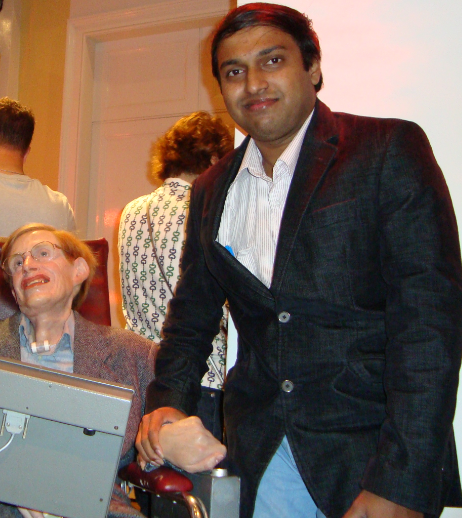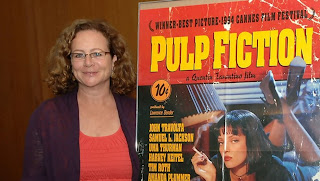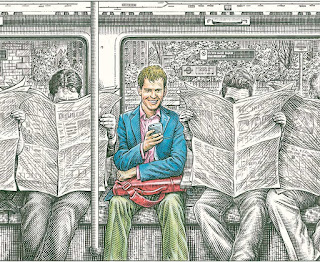ON Mathematician Srinivasa Ramnujan- The unrecognised lonely personal encounter with TRUTH--->3900 theorems and identities
This is ON Tamilnadu Math wizz R (Dec22-1887 to Apr26-1920). Biography is the subject for people who always in need of ideal to take themselves up.In country like Britian literature,biographies and ideals sell well.Ideals arent bad thing until we compare ourself and let down or give up easy as we are feeling inferior as there is long distance between ourself and the ideals.People love rocky stories which are of rags to riches.There are number of biographies that are famous starting from Experiment with truth,autobiography of an yogi.But R is a unsung hero who isnt received well in his times,whose life is full of pain and struggules.You just cant celebrate the biography than a mans works.Even though we always tend to believe the to get emotional high by branding like GENIUS.Genius always goes with eccentricity and controversy.I always tend to believe that brain is an over hyped organ,but not genius are.
I heard his name in the movie good will hunting,which is about a genius who come from a backward section of society.Recently when I came across the information about the missing boy (fair skinned Thenkalai iyengar) which newspaper The Hindu nostalgiacally captures as an tribute to the 125th birth anniversary.The great mathematician is almost a contemporary of Tamil poet Subramanya Bharathy.Infact i wrote a Screenplay on his life and spoke about them to Mr.KamalHaasan(Indian film actor/filmmaker) and Prabhu Nepal(tamil TV director/producer).Every year, here and there seems an proposal/abandon of a film on him.Here is an article dedicated to him which brings the interesting pieces about him.Here is a man who in the words of Betrand Russell can be described as "the most perfect example I have ever known of genius as traditionally conceived, passionate, profound, intense, and dominating".Here is a man who was a Math scientist in his laboratory(Brain)who is placed before natural phenomena which he encountered like a fairy tale.
R's mother Komala shaped the first part of Ramanujan's life, then surely Hardy must take full credit for bringing Ramanujan's prodigious talents to the attention of the world Mathematical community.His associate Hardy is a complex and fascinating figure in his own right and his personality needs to be explored in the context of his relationship with R. His homosexuality was a part of the constellation and a factor in his championing of the underdog (including women in mathematics), his openness to the unorthodox, and his willingness to take risks. Although bound by their common love for mathematics, the two men were otherwise poles apart both temperamentally and culturally.Hardy is his mentor, who is passionately atheist.Hardy had rated the Indian genius to 100 in mathematics (whereas Hardy gives himself a 25).Hardy authored a famous book "A Mathematician's Apology".American Japanese physicist Michiko Kaku has described him as "a bursting super nova".
Other prominent characters also figure in the life of R - notably Ramanujan's many friends, Narayana Aiyer, Gopalachari, leading lights in the Indian Mathematical establishment, members of the ruling British classes, Sir Francis Spring, the Governor of Madras Presidency, and Cambridge Mathematicians, Neville and Littlewood. Ramanujan is a bit like the Wittgenstein of mathematics: An eccentric genius whose true insights we apparently are still to comprehend. Winchester educated son of a middle class schoolmaster who went up to Cambridge, and at the turn of the 20th century, almost single handed masterminded the rise of English Pure Mathematics.
G.H.Hardy : Born and brought not with a golden spoon. He loves his family. He loves cricket. And he loves mathematics.
Neville: The guy who first saw Ramanujam as a genius. He travelled to India in the first place.
Littlewood: A cute guy who competed with Ramanujam with regard to prime numbers. But the first guy who so untiringly went through all of Ramanujam's papers to give a positive impression of Ramanujam to the skeptic mind of G.H.Hardy.
Sir Francis Spring: Not an Indian Guy....who recognized Ramanujam's talent when Ramanujam was working as a clerk in the Madras Port.
Suprise to hear he was boy who loves food. A mother's boy who loved the brinjal curry. A Man who saw god in every equation he wrote.Never exposed to good life style expcept for that he got 250 pounds a year as an allowance for 5 years commencing from April 1919.
R's Works:
1.Some of his work were on infinite series and on partitions
2.One of his work is Tripos system(was removed in England, such a system is used to judge people to get them into the IITs in India. I frankly feel that the same logic against the tripos system can be used against the entrace exams of the IIT's).
3.Also worked on elliptic functions, continued fractions, and infinite series.
4.The most famous application in physics is in the area of statistical mechanics.
5.Among those who have used Ramanujan's mathematics extensively is W. Backster, the well-known physicist from Australia. He used the famous Rogers-Ramanujan identities i n what is called the hard hexagon model to describe the molecular structure of a thin film.
6.There is a certain type of theta functions identity which has applications in other areas of mathematics, particularly in number theory, called modular equations. He computed 116 of these invariants which are much more complicated. These have applications not only in approximations to pie but in many other areas as well.
7.Theories of partition functions that Ramanujan worked on has enormous scope, like applications in an area called combinatorics — the science of counting, and of course in computing, for choosing the best algorithms for computing Pi.
8.Mock theta functions were worked by R extensively.
9.Ramanujan's formulae have found applications in the field of crystallography and in string theory.)
Contrasting performance of him in school/institute Exams were wonder,which clearly depicts that an educational institutions cant help with genius.Ramanujan's math score in his F.A. exams to get a collegiate education. was only 85 points out of a maximum of 150 in math!Every one of his theorems was worked out, and not devised in a flash. My guess is, Ramanujan probably worked only on the problems that interested him.
One of the problem stated by Hardy was solved by R.The problem is that given a number x, how many prime numbers can be found that are less than x? For example, if x = 20, the answer would be 7 since there are 7 prime numbers less than 20: 2, 3, 7, 11, 13 and 17 and 19. According to Hardy, an expression for x has yet to be found. Ramanujan, however, managed to find a close enough approximation
R's description about 1729 when he was on death bed
1729 was not a dull number but rather a very interesting one. It is the smallest number which can be expressed as a sum of 2 cubes in 2 different ways. for example, is equal to 35, but there are no other two numbers of which the sum of cubes equals 35. However, for the number 1729, we have and both of which are equal to 1729. This is a perfect example illustrating Ramanujan’s magic and intuition with numbers.
 |
| His successor Stephen Hawking one of the greatest living Mathematician |
 |
This is ON Tamilnadu Math wizz R (Dec22-1887 to Apr26-1920). Biography is the subject for people who always in need of ideal to take themselves up.In country like Britian literature,biographies and ideals sell well.Ideals arent bad thing until we compare ourself and let down or give up easy as we are feeling inferior as there is long distance between ourself and the ideals.People love rocky stories which are of rags to riches.There are number of biographies that are famous starting from Experiment with truth,autobiography of an yogi.But R is a unsung hero who isnt received well in his times,whose life is full of pain and struggules.You just cant celebrate the biography than a mans works.Even though we always tend to believe the to get emotional high by branding like GENIUS.Genius always goes with eccentricity and controversy.I always tend to believe that brain is an over hyped organ,but not genius are.
I heard his name in the movie good will hunting,which is about a genius who come from a backward section of society.Recently when I came across the information about the missing boy (fair skinned Thenkalai iyengar) which newspaper The Hindu nostalgiacally captures as an tribute to the 125th birth anniversary.The great mathematician is almost a contemporary of Tamil poet Subramanya Bharathy.Infact i wrote a Screenplay on his life and spoke about them to Mr.KamalHaasan(Indian film actor/filmmaker) and Prabhu Nepal(tamil TV director/producer).Every year, here and there seems an proposal/abandon of a film on him.Here is an article dedicated to him which brings the interesting pieces about him.Here is a man who in the words of Betrand Russell can be described as "the most perfect example I have ever known of genius as traditionally conceived, passionate, profound, intense, and dominating".Here is a man who was a Math scientist in his laboratory(Brain)who is placed before natural phenomena which he encountered like a fairy tale.
R's mother Komala shaped the first part of Ramanujan's life, then surely Hardy must take full credit for bringing Ramanujan's prodigious talents to the attention of the world Mathematical community.His associate Hardy is a complex and fascinating figure in his own right and his personality needs to be explored in the context of his relationship with R. His homosexuality was a part of the constellation and a factor in his championing of the underdog (including women in mathematics), his openness to the unorthodox, and his willingness to take risks. Although bound by their common love for mathematics, the two men were otherwise poles apart both temperamentally and culturally.Hardy is his mentor, who is passionately atheist.Hardy had rated the Indian genius to 100 in mathematics (whereas Hardy gives himself a 25).Hardy authored a famous book "A Mathematician's Apology".American Japanese physicist Michiko Kaku has described him as "a bursting super nova".
Other prominent characters also figure in the life of R - notably Ramanujan's many friends, Narayana Aiyer, Gopalachari, leading lights in the Indian Mathematical establishment, members of the ruling British classes, Sir Francis Spring, the Governor of Madras Presidency, and Cambridge Mathematicians, Neville and Littlewood. Ramanujan is a bit like the Wittgenstein of mathematics: An eccentric genius whose true insights we apparently are still to comprehend. Winchester educated son of a middle class schoolmaster who went up to Cambridge, and at the turn of the 20th century, almost single handed masterminded the rise of English Pure Mathematics.
G.H.Hardy : Born and brought not with a golden spoon. He loves his family. He loves cricket. And he loves mathematics.
Neville: The guy who first saw Ramanujam as a genius. He travelled to India in the first place.
Littlewood: A cute guy who competed with Ramanujam with regard to prime numbers. But the first guy who so untiringly went through all of Ramanujam's papers to give a positive impression of Ramanujam to the skeptic mind of G.H.Hardy.
Sir Francis Spring: Not an Indian Guy....who recognized Ramanujam's talent when Ramanujam was working as a clerk in the Madras Port.
Suprise to hear he was boy who loves food. A mother's boy who loved the brinjal curry. A Man who saw god in every equation he wrote.Never exposed to good life style expcept for that he got 250 pounds a year as an allowance for 5 years commencing from April 1919.
R's Works:
1.Some of his work were on infinite series and on partitions
2.One of his work is Tripos system(was removed in England, such a system is used to judge people to get them into the IITs in India. I frankly feel that the same logic against the tripos system can be used against the entrace exams of the IIT's).
3.Also worked on elliptic functions, continued fractions, and infinite series.
4.The most famous application in physics is in the area of statistical mechanics.
5.Among those who have used Ramanujan's mathematics extensively is W. Backster, the well-known physicist from Australia. He used the famous Rogers-Ramanujan identities i n what is called the hard hexagon model to describe the molecular structure of a thin film.
6.There is a certain type of theta functions identity which has applications in other areas of mathematics, particularly in number theory, called modular equations. He computed 116 of these invariants which are much more complicated. These have applications not only in approximations to pie but in many other areas as well.
7.Theories of partition functions that Ramanujan worked on has enormous scope, like applications in an area called combinatorics — the science of counting, and of course in computing, for choosing the best algorithms for computing Pi.
8.Mock theta functions were worked by R extensively.
9.Ramanujan's formulae have found applications in the field of crystallography and in string theory.)
Contrasting performance of him in school/institute Exams were wonder,which clearly depicts that an educational institutions cant help with genius.Ramanujan's math score in his F.A. exams to get a collegiate education. was only 85 points out of a maximum of 150 in math!Every one of his theorems was worked out, and not devised in a flash. My guess is, Ramanujan probably worked only on the problems that interested him.
One of the problem stated by Hardy was solved by R.The problem is that given a number x, how many prime numbers can be found that are less than x? For example, if x = 20, the answer would be 7 since there are 7 prime numbers less than 20: 2, 3, 7, 11, 13 and 17 and 19. According to Hardy, an expression for x has yet to be found. Ramanujan, however, managed to find a close enough approximation
R's description about 1729 when he was on death bed
1729 was not a dull number but rather a very interesting one. It is the smallest number which can be expressed as a sum of 2 cubes in 2 different ways. for example, is equal to 35, but there are no other two numbers of which the sum of cubes equals 35. However, for the number 1729, we have and both of which are equal to 1729. This is a perfect example illustrating Ramanujan’s magic and intuition with numbers.



Comments